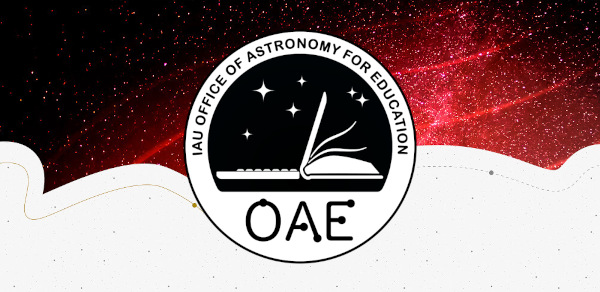This page describes an image Sky Over the Town of Nindirí, in Masaya, Nicaragua
Caption:
Honourable mention in the 2022 IAU OAE Astrophotography Contest, category Still images of celestial patterns.
This image was taken in Tisma, Nicaragua, in April 2022 during a night illuminated by the Moon. Still, some constellations are visible, but the Milky Way, which runs through the image with some of its brightest regions, hides in the celestial background, partially obscured by terrestrial clouds.
The Scorpion, one of the constellations of the Zodiac, is seen on the left side. We can first spot the brightest star, Antares, in the middle of a group of three in an asterism that looks like the stem of a flower growing from the clouds upwards. Its petals are the head of the scorpion. In the brightness of moonlight, the orange colour of Antares is not clearly visible. The three stars that comprise the head of the scorpion are called Acrab, Dschubba and Fang. They were recently named by the IAU in order to show the global diversity of constellations. Acrab is the Arabic term for the scorpion and Fang (The Room) is the name of the Chinese constellation made out of these stars. The Scorpion’s tail extends to the bottom of the image with the sting just above the horizon in the gap between clouds.
The constellation Centaurus is visible in the middle of this image. We can first recognise Crux and the two pointer stars, Alpha and Beta Centauri right above the clouds. The pointers are the front hooves of the centaur, while the stars of Crux were originally (before Christanity, in antiquity) considered one of the rear legs of the centaur. The stars in the front hooves are Rigil Kentaurus (mixed Arabic and Latin meaning The Foot of the Centaur), to the left, and Hadar, to the right. With Crux at the rear they comprise the legs of the mythological creature’s horse body. The humanoid torso is represented by two bright stars on the shoulders and three fainter stars for the head. The star tale says that this figure represents Chiron, the only decent one among the centaurs who was well educated and the teacher of all great heroes.
The Christian navigators who sailed to the New World around 1500 used these asterisms, although they had never seen them before in Europe. These included explorer Amerigo Vespucci whose name was given to the continent America. His shipmate Andrea Corsali, who came from Florence, where the poet Dante Alighieri was famous for his Divine Comedy written two centuries earlier, was reminded of Dante's poem by the four bright stars of Crux. It was probably in this context that they happened to invent the constellation Crux. Originally, the navigators only used the asterism for practical purposes but some time later, in the period of Christian religious wars between several new churches, celestial cartographers used the cross as a symbol of unity and against war.
Credit:
René Antonio Urroz Álvarez/IAU OAE
DOI: 10.5281/zenodo.7425594
Related glossary terms:
Alpha Centauri
, Scorpius
Categories:
Naked Eye Astronomy
License: Creative Commons Attribution 4.0 International (CC BY 4.0) Creative Commons Attribution 4.0 International (CC BY 4.0) icons
The media file captions presented on the OAE website were written, translated and reviewed by a collective effort from the OAE, the OAE Centers and Nodes, the OAE National Astronomy Education Coordinators (NAECs) and other volunteers. You can find a full list of credits for our translation project here. All media file captions are released under a Creative Commons CC BY-4.0 license and should be credited to "IAU OAE". The media files themselves may have different licenses (see above) and should be credited as listed above under "credit".
Captions in Different Languages:
Caption: Lobende Erwähnung beim IAU OAE Astrofoto-Wettbewerb 2022, Kategorie Weitwinkelaufnahmen von Himmelsmustern.
Dieses Bild wurde im April 2022 in einer vom Mond aufgehellten Nacht in Tisma in Nicaragua aufgenommen. Einige Sternbilder sind dennoch sichtbar, aber die Milchstraße, die sich mit einigen ihrer hellsten Regionen durch das Bild zieht, versteckt sich im Himmelshintergrund, teilweise verdeckt auch durch irdische Wolken.
Der Skorpion (lat. Scorpius), eines der Sternbilder des Tierkreises, befindet sich auf der linken Seite. Antares, dessen hellster Stern, befindet sich in der Mitte einer Gruppe aus drei Sternen, die wie der Stiel einer Blume aussieht, die aus den Wolken nach oben wächst. Die Blütenblätter sind der Kopf des Skorpions. Bei der Helligkeit des Mondes ist die orange Farbe von Antares nicht deutlich sichtbar. Die drei Sterne, aus denen der Kopf des Skorpions besteht, heißen Acrab, Dschubba und Fang. Sie wurden kürzlich von der IAU benannt, um die globale Vielfalt der Sternbilder zu zeigen. Acrab ist die arabische Bezeichnung für den Skorpion und Fang (der Raum) ist der Name des chinesischen Sternbilds, das aus diesen Sternen besteht. Der Schwanz des Skorpions reicht bis zum unteren Rand des Bildes, wobei der Stachel knapp über dem Horizont in der Wolkenlücke zu sehen ist.
Das Sternbild Zentaur (lat. Centaurus) ist in der Mitte des Bildes zu sehen. Leichter sind das Kreuz des Südens (lat. Crux) und die beiden Zeigersterne alpha und beta Centauri direkt über den Wolken zu erkennen. Die Zeigersterne sind die vorderen Hufe des Zentauren, während die Sterne des Kreuzes ursprünglich (vor dem Christentum, in der Antike) als eines der Hinterbeine des Zentauren angesehen wurden. Die Sterne in den vorderen Hufen sind Rigil Kentaurus (eine Mischung aus arabischer und lateinischer Bedeutung: der Fuß des Zentauren) links und Hadar rechts. Zusammen mit dem Kreuz am hinteren Ende bilden sie die Beine des Pferdekörpers des mythologischen Wesens. Der humanoide Torso wird durch zwei helle Sterne als Schultern und drei schwächere Sterne für den Kopf dargestellt. Die Mythologie besagt, dass diese Figur Chiron darstellt, den einzigen anständigen unter den Zentauren, der sehr gebildet und der Lehrer aller großen Helden war.
Die christlichen Seefahrer, die um 1500 in die Neue Welt segelten, benutzten diese Asterismen, obwohl sie sie in Europa noch nie gesehen hatten. Zu ihnen gehörte der Entdecker Amerigo Vespucci, der dem Kontinent Amerika seinen Namen gab. Sein Schiffskamerad Andrea Corsali, der aus Florenz stammte, wo der Dichter Dante Alighieri für seine zwei Jahrhunderte zuvor verfasste Göttliche Komödie berühmt war, fühlte sich durch die vier hellen Sterne des Kreuzes an Dantes Gedicht erinnert. Wahrscheinlich erfanden sie in diesem Zusammenhang zufällig das Sternbild Crux. Ursprünglich nutzten die Seefahrer den Asterismus nur für praktische Zwecke, aber einige Zeit später, in der Zeit der christlichen Religionskriege zwischen mehreren neuen Kirchen, verwendeten die Himmelskartografen das Kreuz als Symbol der Einheit und gegen den Krieg.
Credit: René Antonio Urroz Álvarez/IAU OAE
Related glossary terms: Alpha Centauri , Skorpion Caption translation status: Not yet approved by a reviewer
Caption translators: Carolin Liefke
Caption: Menzione d'onore al concorso di astrofotografia IAU OAE 2022, categoria Immagini fisse di modelli celesti.
Questa immagine è stata scattata a Tisma, in Nicaragua, nell'aprile 2022 durante una notte illuminata dalla Luna. Sono ancora visibili alcune costellazioni, ma la Via Lattea, che attraversa l'immagine con alcune delle sue regioni più luminose, si nasconde sullo sfondo celeste, parzialmente oscurata dalle nuvole terrestri.
Lo Scorpione, una delle costellazioni dello Zodiaco, è visibile sul lato sinistro. Possiamo innanzitutto individuare la stella più luminosa, Antares, al centro di un gruppo di tre in un asterismo che sembra lo stelo di un fiore che cresce dalle nuvole verso l'alto. I suoi petali sono la testa dello scorpione. Nella luminosità della luna, il colore arancione di Antares non è chiaramente visibile. Le tre stelle che compongono la testa dello scorpione si chiamano Acrab, Dschubba e Fang. Sono state recentemente nominate da IAU per mostrare la diversità globale delle costellazioni. Acrab è il termine arabo per lo scorpione e Fang (La stanza) è il nome della costellazione cinese composta da queste stelle. La coda dello scorpione si estende fino alla parte inferiore dell'immagine, con il pungiglione appena sopra l'orizzonte nello spazio tra le nuvole.
La costellazione del Centauro è visibile al centro della foto. Possiamo riconoscere Croce del Sud e due stelle puntatrici, Alfa e Beta Centauri, sopra le nuvole. I puntatori sono gli zoccoli anteriori del centauro, e le stelle della Croce del Sud (prima di Cristo, nell'antichità) erano considerate una delle zampe posteriori del centauro. Le stelle negli zoccoli anteriori sono Rigil e Kentaurus (misto arabo e latino che significa Il piede del centauro), a sinistra, e Hadar, a destra. Con la Croce del Sud nella parte posteriore, essi costituiscono le zampe del corpo equino della creatura mitologica. Il busto umanoide è rappresentato da due stelle luminose sulle spalle e da tre stelle più deboli per la testa. Il racconto delle stelle dice che questa figura rappresenta Chirone, l'unico decente tra i centauri, ben istruito e maestro di tutti i grandi eroi.
I navigatori cristiani che salparono verso il Nuovo Mondo intorno al 1500 utilizzarono questi asterismi, sebbene non li avessero mai visti prima in Europa. Tra questi c'era l'esploratore Amerigo Vespucci, il cui nome fu dato al continente America. Il suo compagno di bordo Andrea Corsali, che proveniva da Firenze, dove il poeta Dante Alighieri era famoso per la Divina Commedia scritta due secoli prima, si ricordò del poema dantesco per le quattro stelle luminose della Croce del Sud. Fu probabilmente in questo contesto che inventarono la costellazione della Croce del Sud. In origine, i navigatori utilizzavano l'asterismo solo per scopi pratici, ma qualche tempo dopo, nel periodo delle guerre religiose cristiane tra diverse nuove chiese, i cartografi celesti utilizzarono la croce come simbolo di unità e contro la guerra.
Credit: René Antonio Urroz Álvarez/IAU OAE
Related glossary terms: Alfa Centauri , Scorpione Caption translation status: Approved by a reviewer
Caption translators: Giuliana Giobbi
Caption reviewers: Rodolfo Canestrari









